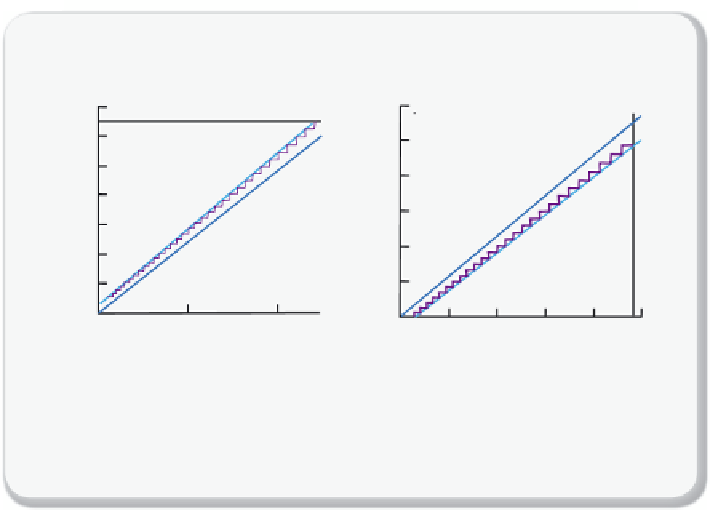Environmental Engineering Reference
In-Depth Information
identifi ed a critical value which causes the operating and equilibrium lines
to cross, which leads to an infi nitely large number of stages. We then
increased L/V by about 20% for the absorbers and decreased L/V by
about 20% for the strippers, which leads to a fi nite number of stages. In
the case of the absorber running on water, the critical L/V value was
2,500, which we increased by 20% to 3,000. In the case of the stripper
running on water, the critical L/V value was about 8,800, which we
reduced by 20% to about 7,040. For the 30% MEA case, we fi rst utilized
the same L/V ratios as used in the water case for purposes of comparison.
Then, in a separate comparison, we adjusted the L/V ratios for the 30%
MEA case to achieve the same number of trays as used in the water case.
The McCabe-Thiele diagram for using water in both the stripper and
absorber is shown in
Figure 5.8.2.
In each case, we have optimized the
liquid to vapor ratio (L/V) so as to minimize utility costs. We begin on the
operating line and then sequentially “step-off” stages. We used a typical
stage effi ciency of 0.4; as a result, when we step off the operating line
toward the equilibrium line, we only go 40% of the way to the equilibrium
line. Given these parameters, we see that the absorber requires 33
stages and the stripper requires 27 stages.
(a)
Adsorber using water as solvent
(b)
Stripper using water as solvent
equilibrium line
maximum mole fraction
minimum mole fraction
operating line
stages
0.14
Bottom
0.30
equilibrium line
maximum mole fraction
minimum mole fraction
operating line
stages
0.12
0.25
Top
0.10
0.20
0.08
0.15
0.06
0.04
0.10
0.05
0.02
To p
Bottom
0
0
0 0.00002 0.00004
0 0.00002 0.00004
Mole fraction of CO
2
in a solvent (x)
Mole fraction of CO
2
in a solvent (x)
Figure 5.8.2
McCabe-thiele diagrams for water
McCabe-Thiele diagrams for (a) an absorber with 33 stages operating at an L/V ratio of
3,000 and (b) a stripper with 27 stages operating at an L/V ratio of 7,000; both units are
using water as the solvent.



















Search WWH ::

Custom Search